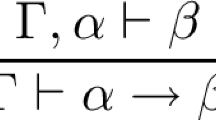Abstract
Logical matrices for orthomodular logic are introduced. The underlying algebraic structures are orthomodular lattices, where the conditional connective is the Sasaki arrow. An axiomatic calculusOMC is proposed for the orthomodular-valid formulas.OMC is based on two primitive connectives — the conditional, and the falsity constant. Of the five axiom schemata and two rules, only one pertains to the falsity constant. Soundness is routine. Completeness is demonstrated using standard algebraic techniques. The Lindenbaum-Tarski algebra ofOMC is constructed, and it is shown to be an orthomodular lattice whose unit element is the equivalence class of theses ofOMC.
Similar content being viewed by others
References
J. C. Abbott,Orthoimplication algebras,Studia, Logica 35 (1976), pp. 173–77.
A. R. Anderson andN. D. Belnap,Entailment vol. I, Princeton University Press, Princeton 1975.
G. Birkhoff,Lattice Theory, American Mathematical Society Colloquium Publications, Providence 1967.
G. Birkhoff andJ. Von Neumann,The logic of quantum mechanics Annals of Mathematics 37 (1936), pp. 823–43.
T. S. Blyth andM. F. Janowitz,Residuation Theory, Pergamon Press, Oxford 1972.
I. D. Clark,An axiomatization of quantum logic,The Journal of Symbolic Logic 38 (1973), pp. 389–92.
J. M. Dunn,The algebra of R,Entailment, vol. I, Princeton University Press, Princeton 1975, pp. 349–71.
P. D. Finch,Sasaki projections on orthocomplemented posets,Bulletin of the Australian Mathematical Society 1 (1969), pp. 319–24.
—,Quantum logic as an implication algebra, ibid., 2 (1970), pp. 101–6.
R. I. Goldblatt,Semantic analysis of orthologic,Journal of Philosophical Logic 3 (1974), pp. 19–35.
R. J. Greechie andS. P. Gudder,Quantum logics, in C.A. Hooker (ed.),Coniemporary Research in the Foundations and Philosophy of Quantum Theory, D. Reidel, Dordrecht 1973.
I. Hacking,Why orthomodular quantum logic is logic, unpublished manuscript.
G. M. Hardegree,The conditional in quantum logic,Synthese 29 (1974), pp. 63–80, reprinted in P. A. Suppes (ed.)Logic and Probability in Quantum Mechanics D. Reidel, Dordrecht 1976, pp. 55–72.
—,Quasi-implicative lattices and the logic of quantum mechanics,Zeitschrift für Naturforschung 30a (1975), pp. 1347–60.
—,Stalnaker conditionals and quantum logic,Journal of Philosophical Logic 4 (1975), pp. 399–421.
-,Material implication in orthomodular (and Boolean) lattices,Notre Dame Journal of Formal Logic in press.
-,Quasi-implication algebras, part I:Elementary Theory, part II:Structure Theory,Algebra Universalis, in press.
—,The conditional in abstract and concrete quantum logic, in C. A. Hooker (ed.)The Logico-Algebraic Approach to Quantum Mechanics, vol. 2, D. Reidel, Dordrecht 1979, pp. 49–108.
-,Axiomatizing the class of orthomodular quantum logically valid arguments, to appear.
L. Herman, E. Marsden andR. Piziak,Implication connectives in orthomodular lattices,Notre Dame Journal of Formal Logic 16 (1975), pp. 305–28.
L. Herman andR. Piziak,Modal propositional logic on an orthomodular basis,The Journal of Symbolic Logic 39 (1974), pp. 478–88.
S. S. Holland,The current interest in orthomodular lattices, in J. C. Abbott (ed.)Trends in Lattice Theory, Van Nostrand Reinhold, New York, 1970.
G. Kalmbach,Orthomodular logic,Zeitschrift für Mathematische Logik und Grundlagen der Mathematik 20 (1974), pp. 395–406.
R. J. Kimble,Ortho-implication algebras,Notices of the American Mathematical Society 16 (1969), p. 772.
J. Kotas,An axiom system, for the modular logic,Studia Logica 21 (1967), pp. 17–38.
H. Kunsemüller,Zur axiomatik der quantenlogik,Philosophia Naturalis 8 (1964), pp. 363–76.
P. Mittelstaedt,On the interpretation of the lattice of subspaces of Hubert Space as a prepositional calculus,Zeitschrift für Naturforschung 27a (1972), pp, 1358–62.
P. Mittelstaedt andE. W. Stachow,Operational foundation of quantum logic.Foundations of Physics 4 (1974), pp. 355–65.
R. Piziak,Orthomodular lattices as implication algebras,Journal of Philosophical Logic 3 (1974), pp. 413–18.
U. Sasaki,Orthocomplemented lattices satisfying the exchange axiom,Journal of Science of the Hiroshima University 17a (1954), pp. 293–302.
B. C. van Fraassen,Formal Semantics and Logic, Macmillan, New York 1971.
J. Von Neumann,The Mathematical Foundations of Quantum Mechanics Tr. R. T. Beyer, Princeton University Press, Princeton 1955.
J. J. Zeman,Quantum logic with implication,Notre Dame Journal of Formal Logic 20 (1979), pp. 723–728.
Author information
Authors and Affiliations
Additional information
This research was supported by National Science Foundation Grant Number SOC76-82527.
Rights and permissions
About this article
Cite this article
Hardegree, G.M. An axiom system for orthomodular quantum logic. Stud Logica 40, 1–12 (1981). https://doi.org/10.1007/BF01837551
Received:
Revised:
Issue Date:
DOI: https://doi.org/10.1007/BF01837551




